CHEVROLET TRACKER 1997 Owners Manual
Manufacturer: CHEVROLET, Model Year: 1997, Model line: TRACKER, Model: CHEVROLET TRACKER 1997Pages: 388, PDF Size: 20.12 MB
Page 301 of 388
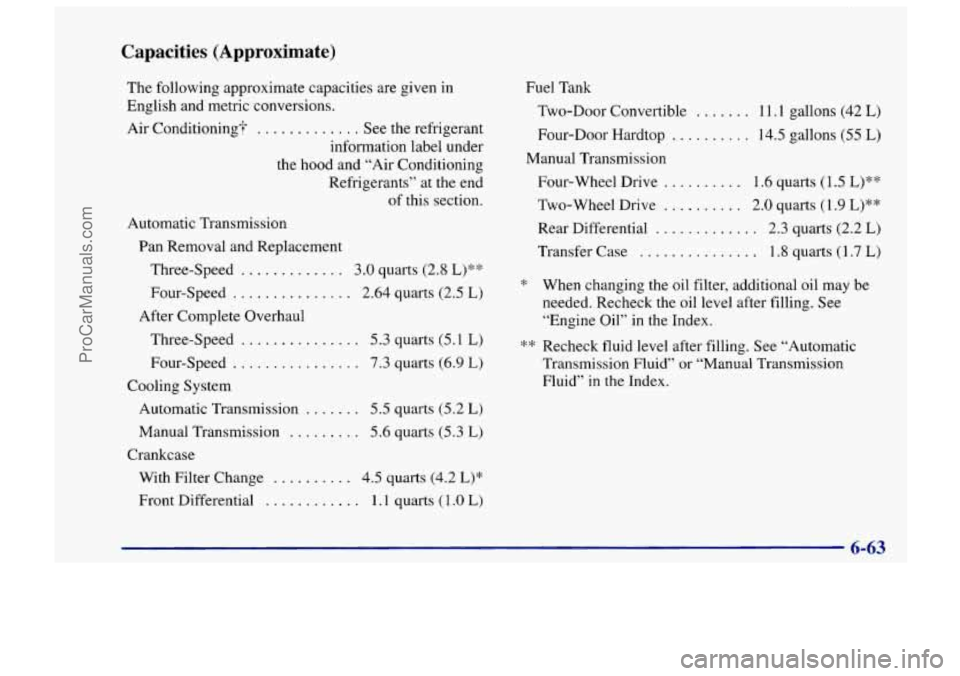
Capacities (Approximate)
The following approximate capacities are given in
English and metric conversions.
Air Conditioning?
............. See the refrigerant
information label under
the hood and “Air Conditioning
Refrigerants” at the end
of this section.
Automatic Transmission
Pan Removal and Replacement Three-Speed
............. 3.0 quarts (2.8 L)**
Four-Speed ............... 2.64 quarts (2.5 L)
After Complete Overhaul
Three-Speed
............... 5.3 quarts (5.1 L)
Four-Speed ................ 7.3 quarts (6.9 L)
Cooling System
Automatic Transmission
....... 5.5 quarts (5.2 L)
Manual Transmission ......... 5.6 quarts (5.3 L)
Crankcase With Filter Change
.......... 4.5 quarts (4.2 L)*
Front Differential ............ 1.1 quarts (1 .O L)
Fuel Tank
Two-Door Convertible
....... 11.1 gallons (42 L)
Four-Door Hardtop .......... 14.5 gallons (55 L)
Manual Transmission
Four-wheel Drive
.......... 1.6 quarts (1.5 L)**
Two-Wheel Drive .......... 2.0 quarts (1.9 L)**
Rear Differential ............. 2.3 quarts (2.2 L)
Transfer Case ............... 1.8 quarts (1.7 L)
* When changing the oil filter, additional oil may be
needed. Recheck the oil level after filling. See
“Engine Oil” in the Index.
** Recheck fluid level after filling. See “Automatic
Transmission Fluid” or “Manual Transmission
Fluid” in
the Index.
6-63
ProCarManuals.com
Page 302 of 388
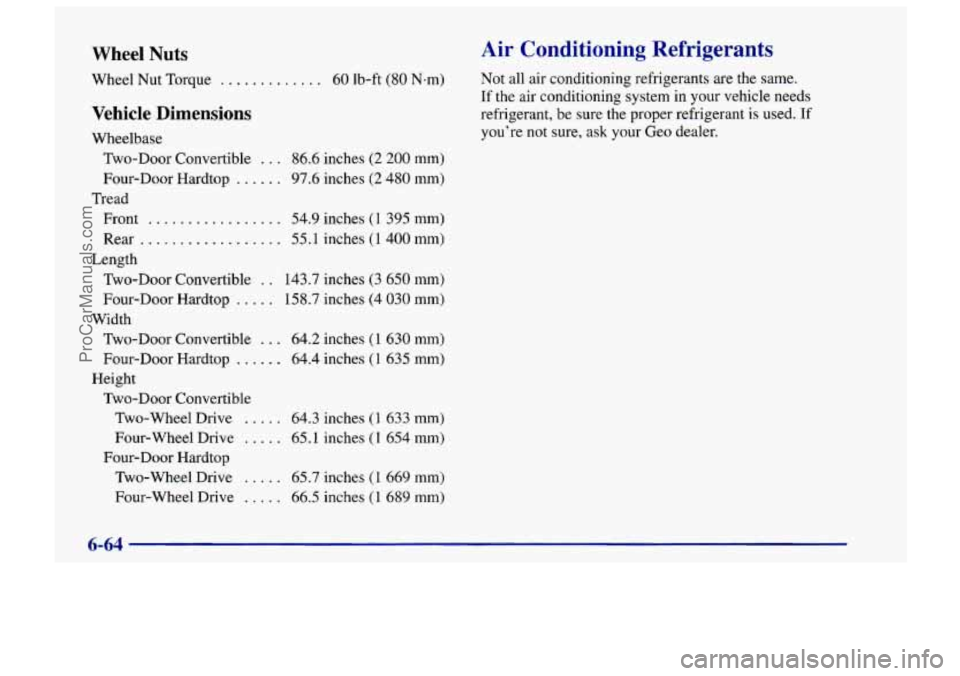
Wheel Nuts
Wheel Nut Torque ............. 60 lb-ft (80 N-m)
Vehicle Dimensions
Wheelbase
Two-Door Convertible
... 86.6 inches (2 200 mm)
Four-Door Hardtop
...... 97.6 inches (2 480 mm)
Front
................. 54.9 inches (1 395 mm)
Rear
.................. 55.1 inches (1 400 mm)
Two-Door Convertible
. . 143.7 inches (3 650 mm)
Four-Door Hardtop
..... 158.7 inches (4 030 mm)
Tread
Length
Width Two-Door Convertible
... 64.2 inches (1 630 mm)
Four-Door Hardtop ...... 64.4 inches (1 635 mm)
Two-Door Convertible
Height
Two-Wheel Drive
..... 64.3 inches (I 633 mm)
Four-wheel Drive ..... 65.1 inches (1 654 mm)
Two-Wheel Drive ..... 65.7 inches (1 669 mm)
Four-wheel Drive
..... 66.5 inches (1 689 mm)
Four-Door Hardtop
Air Conditioning Refrigerants
Not all air conditioning refrigerants
are the same.
If the air conditioning system in your vehicle needs
refrigerant, be sure the proper refrigerant
is used. If
you’re not sure, ask your Geo dealer.
6-64
ProCarManuals.com
Page 303 of 388
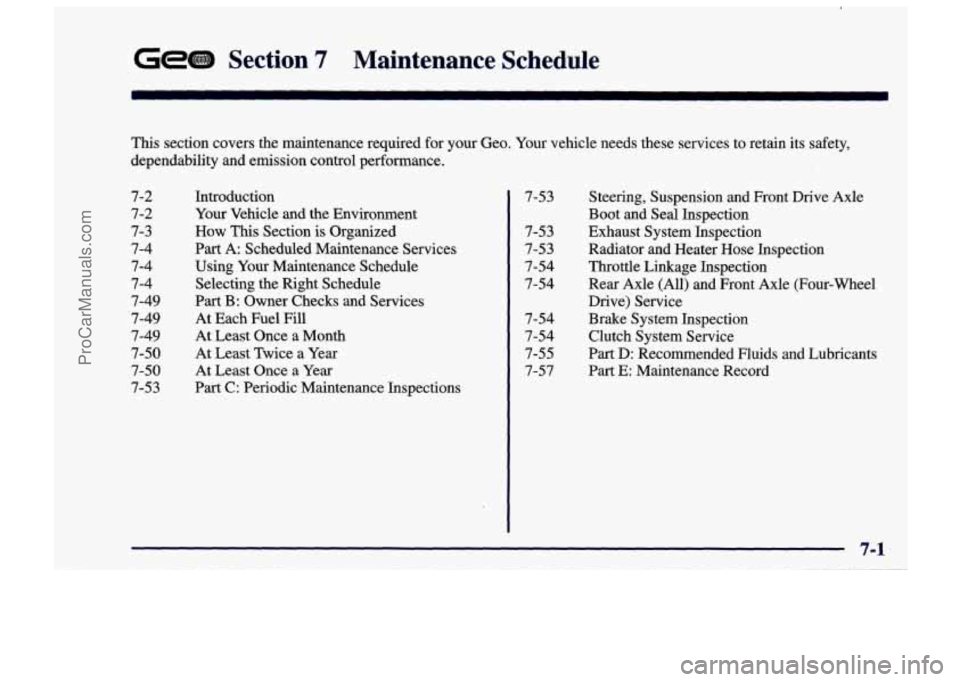
GeGS Section 7 Maintenance Schedule
This section covers the maintenance required for your Geo. Your vehicle needs these services to retain its safety,
dependability and emission control performance.
7-2
7-2
7-3
7-4 7-4
7-4
7-49 7-49
7-49
7-50
7-50
7-53
Introduction Your Vehicle and the Environment
How This Section is Organized
Part A: Scheduled Maintenance Services
Using Your Maintenance Schedule
Selecting the Right Schedule
Part B: Owner Checks and Services
At Each Fuel Fill
At Least Once a Month
At Least Twice
a Year
At Least Once a Year
Part C: Periodic Maintenance Inspections
7-53
7-53
7-53
7-54
7-54
7-54
7-54
7-55
7-57
Steering, Suspension and Front Drive Axle
Boot and Seal Inspection
Exhaust System Inspection
Radiator and Heater Hose Inspection
Throttle Linkage Inspection Rear Axle (All) and Front Axle (Four-wheel
Drive) Service
Brake System Inspection
Clutch System Service
Part D: Recommended Fluids and Lubricants
Part E: Maintenance Record
7-1
ProCarManuals.com
Page 304 of 388
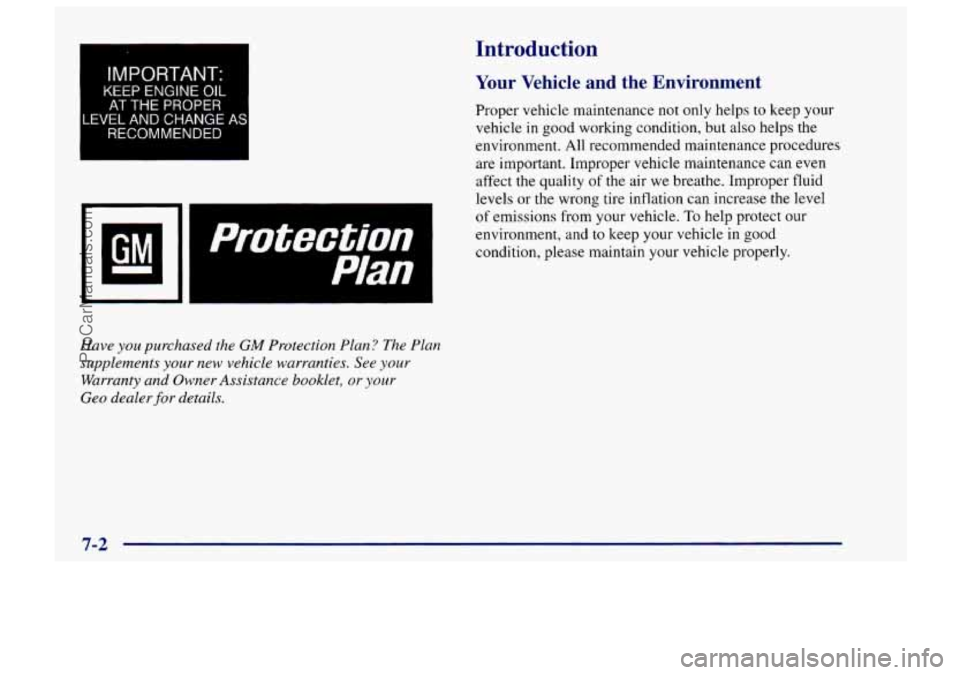
I
IMPORTANT.
KEEP ENGINE OIL
AT THE PROPER
LEVEL AND CHANGE AS
RECOMMENDED
Have you purchased the GM Protection Plan? The Plan
supplements
your new vehicle warranties. See your
Warranty and Owner Assistance booklet, or your
Geo dealer for details.
Introduction
Your Vehicle and the Environment
Proper vehicle maintenance not only helps to keep your
vehicle
in good working condition, but also helps the
environment. All recommended maintenance procedures
are important. Improper vehicle maintenance can even
affect the quality
of the air we breathe. Improper fluid
levels or the wrong tire inflation can increase the level
of emissions from your vehicle. To help protect our
environment, and to keep your vehicle in good
condition, please maintain your vehicle properly.
7-2
ProCarManuals.com
Page 305 of 388
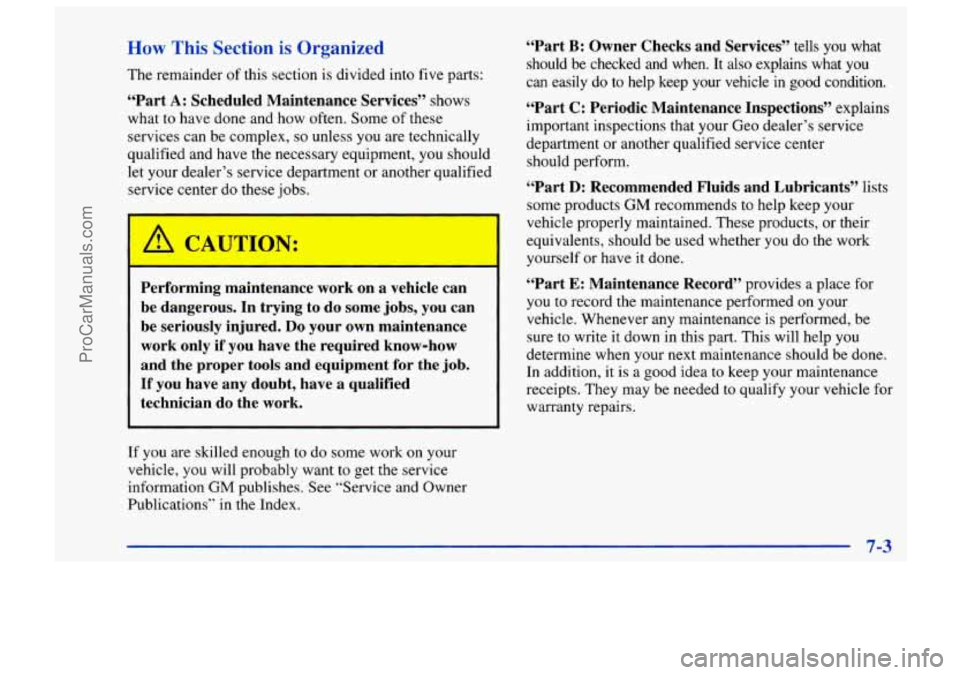
How This Section is Organized
The remainder of this section is divided into five parts:
“Part A: Scheduled Maintenance Services” shows
what
to have done and how often. Some of these
services can be complex,
so unless you are technically
qualified and have the necessary equipment, you should
let your dealer’s service department or another qualified
service center do these jobs.
’A CAUTION:
Performing maintenance work on a vehicle can
be dangerous. In trying to do some jobs, you can
be seriously injured.
Do your own maintenance
work only if you have the required know-how
and the proper tools and equipment
for the job.
If you have any doubt, have a qualified
technician do the work.
If you are skilled enough to do some work on your
vehicle, you will probably want to get the service
information
GM publishes. See “Service and Owner
Publications” in the Index.
“Part B: Owner Checks and Services” tells you what
should be checked and when. It also explains what you
can easily do to help keep your vehicle in good condition.
“Part C: Periodic Maintenance Inspections” explains
important inspections that your Geo dealer’s service
department
or another qualified service center
should perform.
“Part D: Recommended Fluids and Lubricants” lists
some products
GM recommends to help keep your
vehicle properly maintained. These products, or their
equivalents, should be used whether you do the work
yourself
or have it done.
“Part E: Maintenance Record” provides a place for
you to record the maintenance performed on your
vehicle. Whenever any maintenance is performed, be
sure to write it down in this part. This will help you
determine when your next maintenance should be done.
In addition, it is a good idea to keep your maintenance
receipts. They may be needed
to qualify your vehicle for
warranty repairs.
7-3
ProCarManuals.com
Page 306 of 388
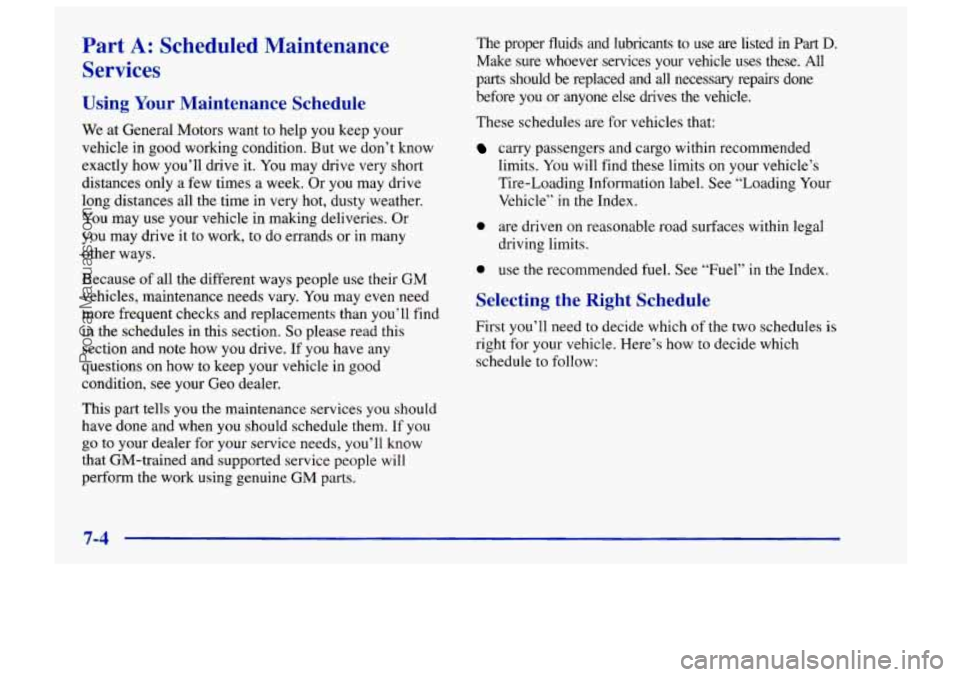
Part A: Scheduled Maintenance
Services
Using Your Maintenance Schedule
We at General Motors want to help you keep your
vehicle in good working condition. But we don’t know
exactly how you’ll drive it.
You may drive very short
distances only a few times a week. Or you may drive
long distances all the time in very hot, dusty weather.
You may
use your vehicle in making deliveries. Or
you may drive it to work, to do errands or in many
other ways.
Because of all the different ways people
use their GM
vehicles, maintenance needs vary. You may even need
more frequent checks and replacements than you‘ll find
in the schedules in this section.
So please read this
section and note how you drive.
If you have any
questions on how to keep your vehicle in good
condition, see your Geo dealer.
This part tells you the maintenance services you should
have done and when you should schedule them. If you
go to your dealer for your service needs, you’ll know
that GM-trained and supported service people will
perform the work using genuine GM parts. The
proper fluids and lubricants to use are listed in
Part D.
Make sure whoever services your vehicle uses these. All
parts should be replaced and all necessary repairs done
before you or anyone else drives the vehicle.
These schedules are for vehicles that:
carry passengers and cargo within recommended
limits. You will find these limits on your vehicle’s
Tire-Loading Information label. See “Loading Your
Vehicle”
in the Index.
0 are driven on reasonable road surfaces within legal
driving limits.
0 use the recommended fuel. See “Fuel’’ in the Index.
Selecting the Right Schedule
First you’ll need to decide which of the two schedules is
right for your vehicle. Here’s how to decide which
schedule to follow:
7-4
ProCarManuals.com
Page 307 of 388
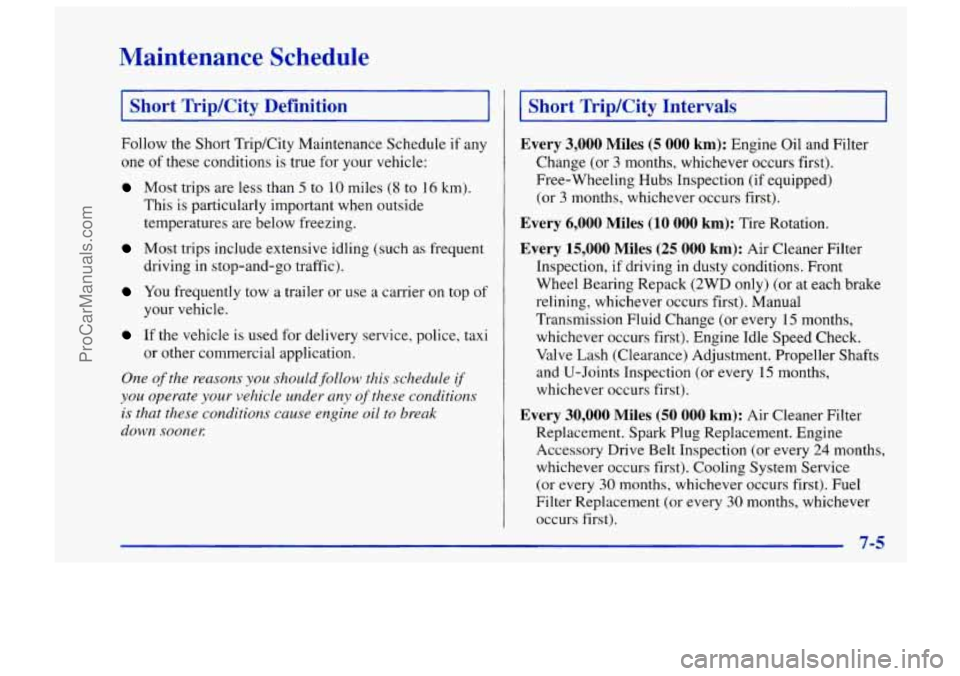
Maintenance Schedule
Short Trip/City Definition
Follow the Short Trip/City Maintenance Schedule if any
one
of these conditions is true for your vehicle:
Most trips are less than 5 to 10 miles (8 to 16 km).
This is particularly important when outside
temperatures are below freezing.
Most trips include extensive idling (such as frequent
driving in stop-and-go traffic).
You frequently tow a trailer or use a carrier on top of
your vehicle.
If the vehicle is used for delivery service, police, taxi
or other commercial application.
One of the reasons you should follow this schedule if
you operate your vehicle under any of these conditions
is that these conditions
cause engine oil to breuk
down sooneE
Short Trip/City Intervals
Every 3,000 Miles (5 000 km): Engine Oil and Filter
Change (or
3 months, whichever occurs first).
Free-Wheeling Hubs Inspection (if equipped)
(or
3 months, whichever occurs first).
Every 6,000 Miles (10 000 km): Tire Rotation.
Every 15,000 Miles (25 000 km): Air Cleaner Filter
Inspection, if driving in dusty conditions. Front
Wheel Bearing Repack (2WD only) (or at each brake
relining, whichever occurs first). Manual
Transmission Fluid Change (or every
15 months,
whichever occurs first). Engine Idle Speed Check.
Valve Lash (Clearance) Adjustment. Propeller Shafts
and U-Joints Inspection (or every
15 months,
whichever occurs first).
Every 30,000 Miles (50 000 km): Air Cleaner Filter
Replacement. Spark Plug Replacement. Engine
Accessory Drive Belt Inspection (or every
24 months,
whichever occurs first). Cooling System Service
(or every
30 months, whichever occurs first). Fuel
Filter Replacement (or every
30 months, whichever
occurs first).
ProCarManuals.com
Page 308 of 388
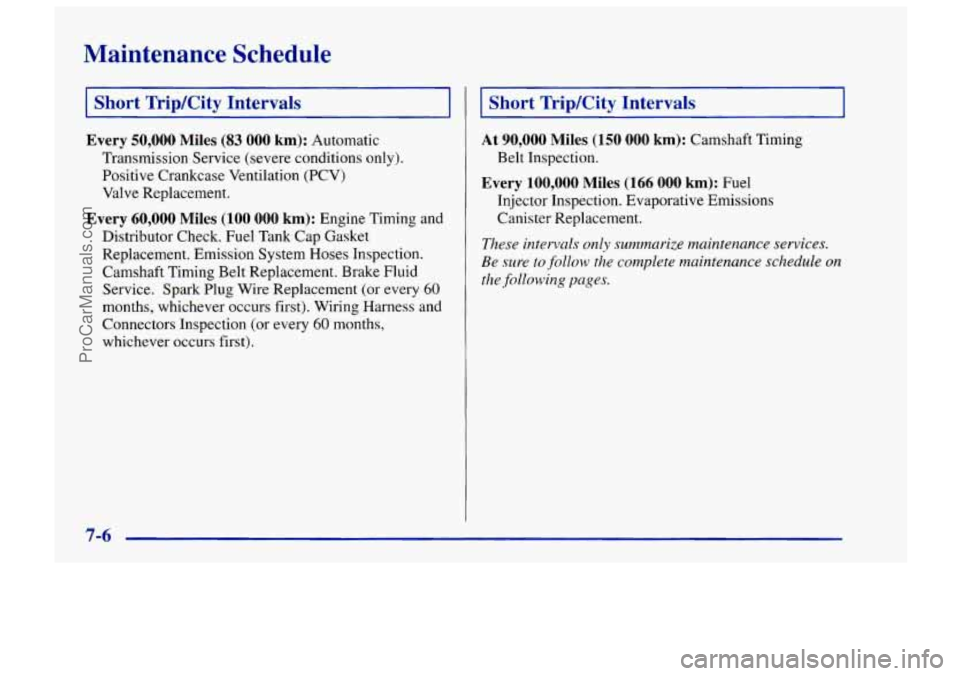
Maintenance Schedule
1 Short TriplCity Intervals I
Every 50,000 Miles (83 000 km): Automatic
Transmission Service (severe conditions only).
Positive Crankcase Ventilation (PCV)
Valve Replacement.
Every 60,000 Miles (100 000 km): Engine Timing and
Distributor Check. Fuel Tank Cap Gasket
Replacement. Emission System Hoses Inspection. Camshaft Timing Belt Replacement. Brake Fluid
Service. Spark Plug
Wire Replacement (or every 60
months, whichever occurs first). Wiring Harness and
Connectors Inspection
(or every 60 months,
whichever occurs first).
Short TriplCity Intervals
At 90,000 Miles (150 000 km): Camshaft Timing
Every 100,000 Miles (166 000 km): Fuel
Belt Inspection.
Injector Inspection. Evaporative Emissions
Canister Replacement.
These intervals only summarize maintenance services.
Be sure
to follow the complete maintenance schedule on
th.e following pages.
7-6
ProCarManuals.com
Page 309 of 388
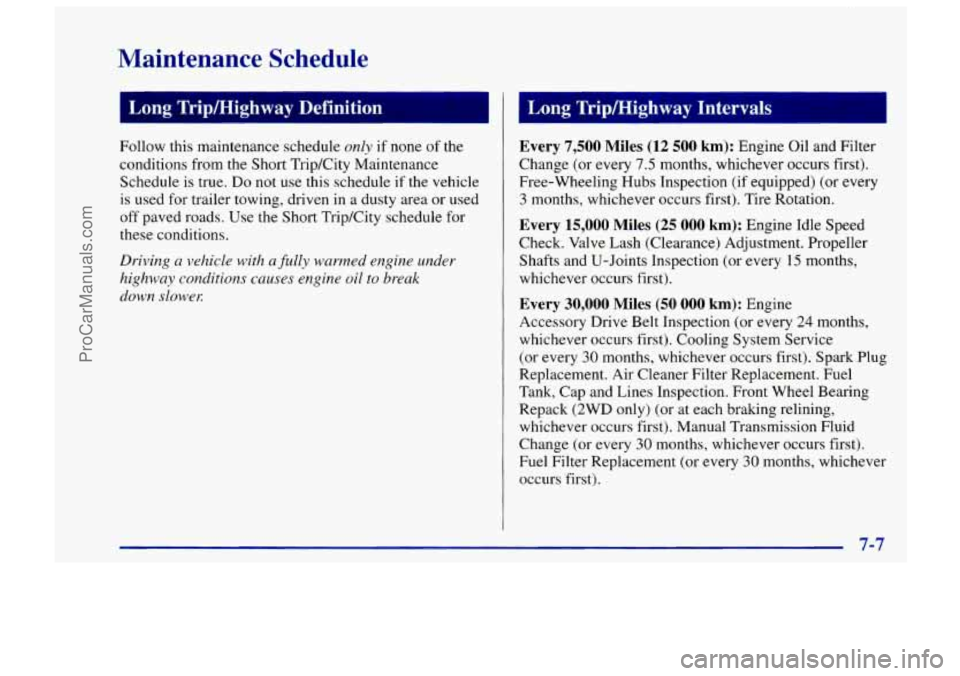
Maintenance Schedule
Follow this maintenance schedule only if none of the
conditions from the Short TripKity Maintenance
Schedule is true.
Do not use this schedule if the vehicle
is used for trailer towing, driven in a dusty area or used
off paved roads. Use the Short TripKity schedule for
these conditions.
Driving a vehicle with a fully warmed engine under
highway conditions causes engine oil to
break
down slower:
Every 7,500 Miles (12 500 km): Engine Oil and Filter
Change (or every
7.5 months, whichever occurs first).
Free-Wheeling
Hubs Inspection (if equipped) (or every
3 months, whichever occurs first). Tire Rotation.
Every 15,000 Miles (25 000 km): Engine Idle Speed
Check. Valve
Lash (Clearance) Adjustment. Propeller
Shafts and U-Joints Inspection (or every
15 months,
whichever occurs first).
Every 30,000 Miles (50 000 km): Engine
Accessory Drive Belt Inspection (or every
24 months,
whichever occurs first). Cooling System Service
(or every
30 months, whichever occurs first). Spark Plug
Replacement. Air Cleaner Filter Replacement. Fuel
Tank, Cap and Lines Inspection. Front Wheel Bearing
Repack (2WD only) (or at each braking relining,
whichever occurs first). Manual Transmission Fluid
Change (or every
30 months, whichever occurs first).
Fuel Filter Replacement (or every
30 months, whichever
occurs first).
7-7
ProCarManuals.com
Page 310 of 388

Maintenance Schedule
Long Tripmighway Intervals fi
Every 50,000 Miles (83 000 km): Automatic
Transmission Service (severe conditions only). Positive
Crankcase Ventilation (PCV) Valve Replacement.
Every 60,000 Miles (100 000 km): Engine Timing and
Distributor Check. Fuel Tank Cap Gasket Replacement.
Emission System Hoses Inspection. Camshaft Timing
Belt Replacement.
Spark Plug Wire Replacement (or
every
60 months, whichever occurs first). Wiring
Harness and Connectors Inspection
(or every 60 months,
whichever occurs first). Brake Fluid Service.
At 90,000 Miles (150 000 km): Camshaft Timing
Belt Inspection.
Every 100,000 Miles (166 000 km): Fuel
Injector Inspection. Evaporative Emissions
Canister Replacement.
These intervals only summarize maintenance services.
Be sure
to follow the complete maintenance schedule on
the following pages.
7-8
ProCarManuals.com